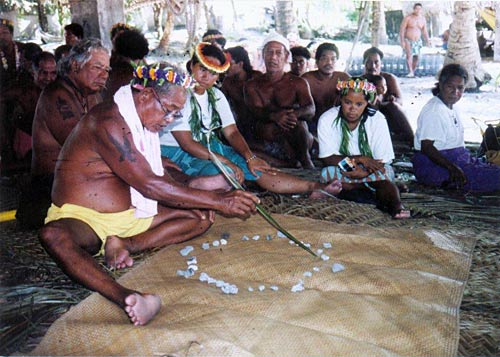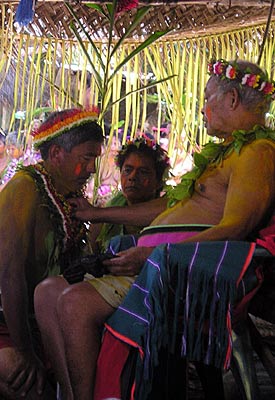Voyager guided rebirth of cultures

Mau Piailug, the navigator who reintroduced Hawaiians to traditional Pacific navigational methods, died Sunday at the age of 78. Piailug is shown explaining his star compass to the crew of the voyaging canoe Makalii in the chief's meetinghouse in Satawal, Micronesia.

Piailug, right, inducts Hokule'a navigator Nainoa Thompson into a select group of Micronesian master navigators during ceremonies on Satawal.


The way-finding navigator from an island of less than a square mile who ushered in a renaissance in open-ocean traditional native sailing across the Pacific has died.
Mau Piailug, 78, died Sunday night and was buried yesterday (Hawaii time) on his home island of Satawal in the western Pacific, said Kathy Muneno, a spokeswoman for the Polynesian Voyaging Society.
Piailug was the navigator who reintroduced Hawaiians to traditional Pacific navigational methods using the stars, moon, wind, currents and birds to find distant lands.
In 1976 he was the navigator sailing aboard the double-hulled sailing canoe Hokule’a on its historic voyage from Hawaii to Tahiti.
The Hokule’a voyage supported the assertion that Polynesians were capable of long-distance voyages centuries before European explorers.
Piailug had suffered from diabetes for many years.
Don't miss out on what's happening!
Stay in touch with breaking news, as it happens, conveniently in your email inbox. It's FREE!
Polynesian Voyage Society President Nainoa Thompson said Piailug’s contribution to restoring the cultures of Pacific islanders was immense.
"Thousands of people are sharing in the sadness," Thompson said. "His contribution to Hawaii and humankind is immeasurable."
In the mid-1970s, Piailug chose to share his knowledge of Pacific way-finding with native Hawaiians when the island cultures here and in Micronesia were experiencing rapid westernization.
Piailug hoped that by sharing his knowledge, the information would be stored elsewhere and would be shared with his people in the future.
The historic Hawaiian voyage to Tahiti in 1976 helped to restore pride in Pacific island cultures and built bridges among various Pacific island cultures through double-hulled canoe voyaging.
Besides Hawaii, other island cultures have formed voyaging societies to promote native voyaging, including in Taiwan, New Zealand, Samoa, Fiji, Guam, Saipan, Palau, Chuuk, Pohnpe, the Marshall Islands and Tahiti.
Satawal island resident Thomas Raffipiy recalled as a youth the night when Piailug consulted with his family and made the decision to help the Hawaiians.
Traditionally, the knowledge was passed down through the family and did not cross cultures.
"It was a decision that he didn’t take lightly," said Raffipiy, Piailug’s nephew. "He was among the youngest of the surviving navigators and hoped the knowledge stored somewhere with someone would come back. … Everything he said has come to pass."
Ben Finney, a founder of the Polynesian Voyaging Society, said Piailug was driven to help by his vision of what needed to be done to revive native cultures through sailing, including Satawal islanders.
"He said, ‘That’s exactly what we need,’" recalled Finney, a former professor at the University of Hawaii.
Finney said Piailug became well known among Polynesians from New Zealand to Hawaii for the generous way in which he shared his knowledge of way-finding navigation.
"He was really an aid giver of ancient knowledge," Finney said.
Piailug’s work came full circle during the 2007 voyage to his home island of Satawal, when Hawaii crews delivered the double-hulled canoe Alingano Maisu as a gift to Piailug.
That year, for the first time in a half-century, Piailug held a "Po" ceremony to induct master navigators into the Weriyeng school of navigation. The group included five Hawaiians and about 10 Micronesians, including his son, Sesario Sewralur.
Sewralur, the captain and navigator of the Alingano Maisu, teaches native navigation at a community college on Palau.
Thompson said to honor Piailug, the Hokule’a plans to sail around the Hawaiian Islands in the near future with crews of young people.
"It’s a very important time to focus on all our teachers, honor them and celebrate them," Thompson said. "We know how much he loved Hawaii, and we know how much he loved the people."
Piailug is survived by more than a dozen children and numerous grandchildren.




